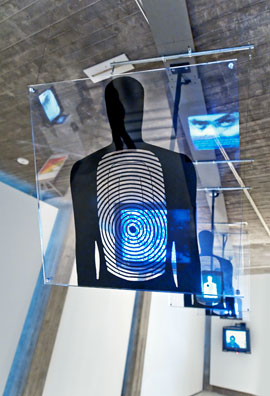(EditorŌĆÖs Note: This article was written by Kate Preziosi ŌĆÖ10)
Members of the 51│į╣Ž═° community who visit the Picker Art Gallery during the next week can experience an exhibition unlike anything the space has hosted before.
includes 13 works by an international group of artists who have engaged, critiqued, and, in some cases, inserted themselves into official channels of broadcast television and radio since the late 1960s.
In order to accommodate the technologically intensive demands of this show, 51│į╣Ž═°ŌĆÖs lead electronics technician John Robinson and carpenter/mason Jeff Golley worked tirelessly to transform the Picker into a media gallery in just two months.
Artist Gregory GreenŌĆÖs WCBS Radio Caroline is an actual short-range pirate radio station. Students were given the opportunity to manage the station for an allotted period of time, and reach anyone within a six-mile radius on 93.7 FM.
 |
| Dara BirnbaumŌĆÖs Hostage, 1994, is part of the Broadcast exhibition that runs through March 12. (Photo by Warren Wheeler) |
The two men joked about the perils of installing the antennae on the roof of Dana Arts Center in the Hamilton winter weather. But for Robinson, it was worth the risk.
ŌĆ£This is where the sixties came out of,ŌĆØ he said of GreenŌĆÖs radio station. ŌĆ£This is where ŌĆśpeace, love, and letŌĆÖs fix all the warsŌĆÖ came from. It was people running around with little pirate transmitters, totally breaking every rule in the world, going up on the air and hopefully staying up on the air long enough to get their message out.ŌĆØ
Golley was in charge of making RobinsonŌĆÖs layout for the exhibition a reality.
In one month, he built new walls to accommodate the artistsŌĆÖ separate requirements, and found innovative ways to conceal the thousands of wires hiding in the immaculate white space.
ŌĆ£We worked together to create what the artists envisioned. I like doing this kind of stuff because itŌĆÖs a lot of thinking on your feet. IŌĆÖm hoping that when all is said and done, that some of these walls will stay, because I think they add character to the space.ŌĆØ
The which opened Feb. 2 and runs through March 12, addresses a broad range of historical events and political debates, sometimes from behind the lenses of some of the first portable video equipment.
Nam June PaikŌĆÖs Video Tape Study No. 3 contains images of news conferences by President Lyndon B. Johnson taken from SonyŌĆÖs Portapack portable video device in 1965. He deftly cuts the audio to project single words and messages, deliberately challenging the power of the broadcast.
Robinson was especially excited about bringing this dynamic collection to Picker because it was such a departure from the galleryŌĆÖs typical exhibitions.
ŌĆ£Nothing against still art, I love it. But this is different. You can become a part of what youŌĆÖre seeing. ItŌĆÖs history that [the studentsŌĆÖ] parents have lived through. ItŌĆÖs the birth of their iPod. ItŌĆÖs a piece of the founding fathers of those who taught us that art was not just ink on a canvas.ŌĆØ